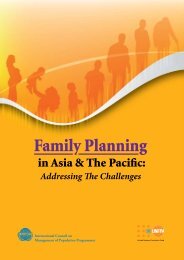Inter-lInkages between PoPulatIon DynamIcs anD DeveloPment In ...
Inter-lInkages between PoPulatIon DynamIcs anD DeveloPment In ...
Inter-lInkages between PoPulatIon DynamIcs anD DeveloPment In ...
You also want an ePaper? Increase the reach of your titles
YUMPU automatically turns print PDFs into web optimized ePapers that Google loves.
• Strengthen reproductive rights and RH of women at all stages of population planning and implementation;• Protect women from HIV/AIDS and STIs through awareness raising; and• Create women-friendly physical facilities at all public health complexes.Adolescent Reproductive Health StrategyThe Adolescent Reproductive Health (ARH) Strategy is for a period of 10 years from 2005-2015. However,for the purpose of pragmatic planning, the detailed planning is limited to 2005-2010.The objectives of the ARH Strategy are to:Since ARH is an overall1. Improve the knowledge of adolescents on RH issues;development issue, it should be2. Create a positive change in the behaviour and attitude of theintegrated in the developmentgatekeepers of adolescents towards RH;planning of the country at the3. Reduce the incidence of early marriage and pregnancy amongnational and sectoral levels.adolescents;4. Reduce the incidence and prevalence of STIs and HIV/AIDS amongARH Strategyadolescents;5. Provide easy access for all adolescents to adolescent-friendly healthservices and other related services; and6. Create favourable conditions which discourage risky behaviours among adolescents.The National Communication Strategy for Family PlanningThe National Communication Strategy for FP formulated in 2006 will provide all programme implementersand service providers the framework for their outreach interventions on FP and RH to change relevant behaviours,thus, contributing to sustainable social development and poverty reduction.The Strategy will contribute to:• Delayed age at marriage;• <strong>In</strong>creased knowledge and demand for FP and improved RH;• <strong>In</strong>creased knowledge and demand for maternal health services;• Improved service delivery;• <strong>In</strong>creased male involvement; and• Improved research and evaluation capacity for FP and RH programmes.The target audiences are the newlyweds and low-parity couples, married couples, husbands/males, poor andunderserved populations, adolescents, unmarried youth, service providers, programme managers andsupervisors, religious and community leaders, political leaders/policy-makers, and mass media personnel.Overall, the policies acknowledge the adverse impact of population growth on developmentand seek to address this through improved knowledge on RH and availability ofcontraceptive and FP services, especially among adolescents and the poor. The focus ofthe policies remains still on reducing fertility and promoting the use of FP and, at thesame time, recognising the need to underline gender equality to accelerate the progressin achieving the MDGs. This shows that a strong policy framework exists to address theimpact of rapid population growth on development. Nevertheless, the development policiesare still weak in relation to how development affects population dynamics.4














